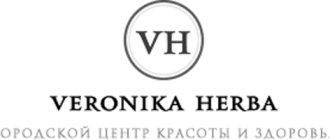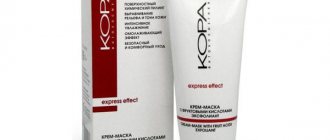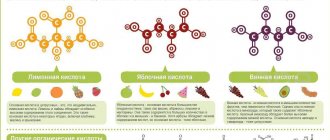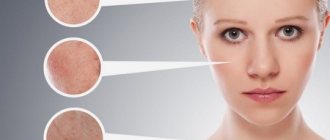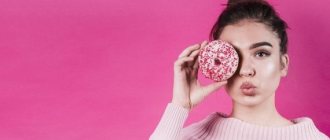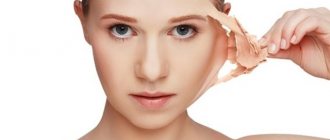Classification of peels by depth of damage
Below is a classification of facial skin peels depending on which layer the acids penetrate, as well as which peels represent each group.
SUPERFICIAL PEELING – up to the germinal layer of the epidermis (epidermal-dermal junction)
- Glycolic acid 30 – 50%
- Lactic acid 10 – 30%
- Mandelic acid 40%
- Salicylic acid up to 30%
- Pyruvic acid up to 50%
- Potential side effects of facial peels: post-inflammatory pigmentation, erythema, itching, burning, superficial peeling/epidermolysis
MEDIUM PEELING – the entire thickness of the epidermis to the papillary layer of the dermis
- Salicylic acid more than 30%, multi-layer application
- Glycolic acid 70%
- TCA 30 – 50%
- Potential side effects of facial peeling: post-inflammatory pigmentation, secondary infection, scars, milia, acne, heavy and deep exfoliation
DEEP PEELINGS – up to the reticular layer of the dermis
- TCA more than 50% (single layer application)
- Phenol peeling
- Potential side effects of deep peels : in addition to those with medium peels + cardiotoxicity/arrhythmia, hepato- and nephrotoxicity
Medium and deep skin peels are most effective in correcting macrostructural changes in the skin (Deep wrinkles and scars), but have a longer and more complex recovery period and an increased risk of scarring and skin dispigmentation.
Contraindications and precautions
Ready-made pharmacy peels for self-use are universal and hypoallergenic. Based on their intensity of impact, they are classified as gentle superficial peels.
Contraindications to use may include individual conditions or characteristics of the body:
- Inflammatory processes on the skin.
- Damage (scratches, burns, abrasions, purulent formations, open wounds).
- Herpetic rashes.
- Increased body temperature, fever.
- Pressure surges.
- Viral and infectious diseases (ARVI, acute respiratory infections).
- Allergic rash or rash of unknown origin.
- Suspicions of cancer.
- General weakened condition of the skin.
- Periods of pregnancy, lactation.
Proven and safe cosmetics: peelings for cleansing, renewing and rejuvenating the skin:
- Arabia;
- Librederm;
- Mary Kay;
- Vichy;
- Christina.
Enriched peelings
These are modern superficial atraumatic peelings, which contain active ingredients that work on facial skin problems.
Developed in accordance with customer requests for an effective and at the same time atraumatic peeling procedure that does not “knock out” the usual rhythm of life.
Classic peelings are effective due to exfoliation and traumatization of the skin - the more peeling, the more pronounced the result.
Differences between enriched peelings
- A low (as a rule) percentage of acids that work on the principle of enhancers - conductors for active ingredients;
- Active ingredients that work on skin problems:
- Peptides
- Plant stem cells
- Antioxidants
- Lightening Ingredients
- Sebum-regulating ingredients, etc.
Benefits of enriched peels
What have the developers of enriched peels achieved and what are their advantages over other types of chemical peels:
- Atraumatic – without redness, peeling and irritation of the skin;
- Allows the client to maintain full social activity;
- High efficiency – comparable to medium peels with heavy peeling;
- Possibility of individual selection for the client according to skin type and problem;
How to use correctly and how often to use
Each finished peeling goes on sale with detailed instructions. It describes how to use it correctly and how often to use it.
To avoid unwanted side effects (burn, redness, peeling, etc.), you should strictly follow the instructions given in the instructions.
General tips for use:
- Before applying peeling to your face for the first time, be sure to test for an allergic reaction.
- Apply a thin layer of peeling to cleansed facial skin with a brush, distributing it evenly over the entire surface.
- Leave for 15-20 minutes, rinse with warm running water.
- The final stage is the application of a moisturizing or nourishing cosmetic product (cream, emulsion, serum).
The number of procedures depends on the age and condition of the skin. For oily, problem skin, it is recommended to cleanse your face 2 times a week. Dry, delicate ones should be cleaned no more than once every 10 days.
To achieve the effect, it is necessary to carry out cleansing in courses of 10-15 procedures with a break of 7-10 days .
How to choose the right facial peel according to your skin type
Which peeling to choose depending on your skin type, because a universal composition effective for all skin types... this is a myth! Let's look at the example of DermaQuest facial peels :
Dry skin
- Acid composition: AHA, at a young age - preference for lactic acid, older - in combination with glycolic acid.
- pH up to 3.5 – work on moisturizing + delicate removal of horny masses.
- Enriched peelings with a high concentration of hyaluronic acid, enzymes, antioxidants and Vitamin C are preferred - they also increase the moisture-retaining function of the skin.
Examples:
Milk peeling for delicate and sensitive skin - the most atraumatic peeling against dryness and dehydration, for all skin types!
Peeling contains lactic acid 30%, micronized hyaluronic acid and red grape stem cells.
The principle of operation of milk peeling: eliminates hyperkeratosis, restores the barrier function of the skin, retains moisture inside the skin and prevents its loss.
2. Oily skin
- Acid composition of the peeling: combination of AHA (in low concentrations) with salicylic acid 2%.
- ANAs loosen the stratum corneum, and salicylic acid (a sebolic in this concentration) dissolves excess fat on the surface of the skin and comedones. Has an antiseptic effect - prevention of rashes.
- pH 3,5 – 2,5
- Enriched peels containing sebum regulators (for example, lilac stem cells), antioxidants and antiseptics.
Examples:
Almond peeling with Azelaic acid and Hibiscus - enriched with Lilac Stem cells, contains azelaic acid and plant extracts with multidirectional effects - restores and moisturizes.
Peeling has a sebum-regulating, antiseptic and antioxidant effect - especially recommended for facial skin prone to oily shine and periodic inflammatory rashes.
Peeling based on pumpkin pulp (basic) – atraumatic skin cleansing. contains pumpkin pulp 40%, salicylic acid 2%, glycolic and lactic acid 3%.
Peeling eliminates comedones, dissolving sebaceous plugs, and has a sebum-regulating and antibacterial effect. Effective for facial skin with grade 0-2 acne.
Due to the warming effect of pyrogens and cleansing with acids and enzymes, peeling works like cleansing the skin.
Increases microcirculation and oxygen supply to tissues, against tissue hypoxia - rejuvenation and resolution of stagnant spots; lymphatic drainage function – against edema.
Sensitive skin
- Acid composition of peeling: preference to milk peeling.
- pH 3.5 – 3.0 (atraumatic).
- Enriched with: hyaluronic acid, additional antioxidants, moisturizing and soothing complexes.
Examples:
Milk peeling for delicate and sensitive skin (see above)
Peeling MangoBright is a moisturizing peeling based on mango pulp, phytic, kojic and lactic acids, enriched with Sweet Orange stem cells, antioxidants and plant extracts with multidirectional effects.
Peeling lightens diffuse perpigmentation on the face, uneven complexion after too much sun and eliminates photoaging of the skin. Inhibits melanin production and tyrosinase enzyme activity.
Completing the MangoBright peeling course guarantees an even skin tone, the skin acquiring a “healthy glow” and a fresh, rested appearance, fullness from the inside.
How to make a remedy at home from pharmacy products?
Facial exfoliation with pharmaceutical products allows you to get your skin in order for little money. The procedure must be carried out regularly, and in order for the effect to last long and to avoid problems, it is necessary to protect the skin from the sun throughout the year.
Yellow (retinoic) with dimexide
Yellow peeling refers to chemical procedures that affect the upper and middle layers of the epidermis. The second name is retinoic peeling .
Retinoid is a structural analogue of vitamin A. Dimexide in this case acts as a preparatory component in the application of retinoic ointment.
- Dilute 1 teaspoon of Dimexide in half a glass of water.
- Wipe the skin.
- Apply retinoid ointment to Dimexide for 45 minutes.
- Wash with a solution of soda (2 teaspoons of soda per 1 glass of water).
- After 6 hours, apply cleansing mousse or foam and moisturize the skin.
Reference . The procedure must be carried out once a month for six months.
With amber and fruit acid
To prepare peeling with amber, you need to purchase succinic acid tablets at the pharmacy.:
- Grind the drug.
- Mix succinic acid, orange or lemon zest in equal portions.
- Dilute the dry mixture with warm water or hydrosol until a paste is obtained.
- Apply a thin layer to the skin and leave for five minutes.
- Apply another layer of mixture on top.
- Massage for several minutes. Do not massage areas where wrinkles form.
- Remove peeling with a cotton pad and wash with warm water.
- Only dry skin types need additional moisturizing.
We recommend: Similarities and differences between procedures: which is better - chemical peeling or laser resurfacing?
If the manipulation is carried out regularly, then amber peeling with fruit acids can :
- refresh and even out the surface of the skin;
- cleanse pores;
- eliminate post-acne;
- remove blackheads.
Next, watch a video about a peeling mask for the face with succinic acid:
Professional glycol
The acid used for exfoliation is a natural alpha hydroxy acid (AHA) derived from fruits and sugar canes.
With this exfoliation you can achieve:
- rejuvenation effect;
- eliminating blackheads, post-acne;
- restoration of the sebaceous glands.
To prepare the peeling you only need two ingredients:
- 10% glycolic acid solution;
- baking soda (2 tsp per 1 glass of cool water).
Soda solution is needed for neutralization.
- Apply glycolic acid to the skin using a pipette and spread over the face.
- After half an hour, rinse the epidermis with soda solution.
Attention! Solutions with a concentration of the active reagent higher than 10–12% cannot be used at home.
In this video you will learn all the details about using glycolic acid as a peeling at home:
A nicotinic acid
What is this? Nicotinic acid, also known as vitamin PP, is a B vitamin. In the body, nicotinic acid is involved in oxidative reactions, the metabolism of proteins and amino acids, the processes of hydrogen transport and tissue respiration. Vitamin PP also dilates small blood vessels and improves blood microcirculation.
Instagram content
This content can also be viewed on the site it originates from.
How does it work? Let's focus on how nicotinic acid will benefit your curls. To answer in one word - huge. Vitamin PP expands peripheral blood vessels and also activates metabolic processes in tissues, which prevents hair loss and stimulates its growth. And the benefits don’t end there: nicotinic acid restores damaged hair follicles and awakens new ones, strengthens roots, reduces sebum production and increases protein synthesis, which makes hair thicker.
Instagram content
This content can also be viewed on the site it originates from.
Additionally, niacin can be used to treat skin problems and rashes. According to a study, using a cream with vitamin PP for two months reduces age spots on the face and evens out skin tone. Another analysis of the properties of nicotinic acid showed that it helps regulate lipid metabolism, thereby improving the overall condition of the skin and reducing rashes and redness. Vitamin PP also works well in the fight against age-related changes - cosmetics with this component help reduce wrinkles.
Instagram content
This content can also be viewed on the site it originates from.
How to use? For hair . In the pharmacy, nicotinic acid is sold in the form of ampoules, each designed for one use, or in a bottle with a dispenser. Apply the product to damp hair after washing. It is necessary to evenly distribute the contents of the ampoule or a little liquid from the bottle over the entire head and rub into the hair roots with massaging movements. There is no need to rinse off the solution. This course can be carried out for two months every two to three days.
For face . Nicotinic acid should be used on the face in combination with other components. For example, vitamin PP forms a wonderful duet with aloe. Take two ampoules of nicotinic acid and mix with one spoon of aloe juice. Apply the resulting mixture to your face and wash off after twenty minutes.
Instagram content
This content can also be viewed on the site it originates from.
Contraindications . But, no matter how wonderful everything may sound, nicotinic acid has contraindications. For example, it can cause allergies, so before use you need to apply the solution to a small area of skin - if there is no redness or allergic reaction, feel free to use it.
Nicotinic acid Renewal, 210 rubles; Nicotinic acid Mirrolla, 128 rubles
